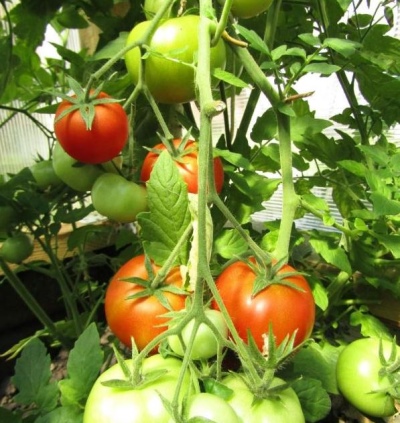
- Authors: Gavrish S.F., Morev V.V., Amcheslavskaya E.V., Volok O.A. (Scientific Research Institute of Vegetable Plant Breeding, LLC Gavrish Breeding Firm)
- Year of approval: 2006
- Name synonyms: Verlioka plus F1
- Category: hybrid
- Growth type: determinant
- Appointment: fresh consumption, for whole fruit preservation
- Ripening period: early
- Ripening time, days: 104-105
- Growing conditions: for open ground, for film greenhouses, for closed ground
- Bush size: medium-sized
Much to the delight of gardeners and gardeners, fans of the magnificent Verlioka variety, a new hybrid has appeared on the market, created on the basis of everyone's favorite. The result surpassed the parent variety in many respects - increased yield, unpretentiousness, and so on. Universal determinant hybrid Verlioka plus (synonym Verlioka plus F1) is used for fresh consumption and for conservation, grown in greenhouses and in the open field.
Breeding history
The emergence of a new hybrid on the market was ensured by the work of breeders of the Russian company Gavrish Breeding Company LLC, Scientific Research Institute for Vegetable Plant Breeding LLC. The authors are S.F. Gavrish, V.V. Morev, E.V.Amcheslavskaya, O.A. Volok. Tomato was approved for use in 2006.
Description of the variety
Medium-sized bushes of moderate foliage, 100-150 cm high, are covered with medium-sized dark green leaves with a bright tomato scent. Yellow flowers are collected in racemose inflorescences, the first of them is laid above 8-9 leaves, all subsequent ones - after 1-2.
Advantages | disadvantages |
High survival rate after transplant | High requirements for soil composition |
Transfers partial shade | The need for shaping and pinning |
Excellent yields when formed in 2-3 stems | |
A large number of ovaries | |
Strong immunity | |
Fruit evenness | |
Versatility in application | |
Good transportability and shelf life | |
Excellent ripening ability |
Brush forms up to 10 large tomatoes.
The main qualities of the fruit
Large flat-round fruits weighing 120-140 grams change from green to bright red at the stage of technical ripeness.
Taste characteristics
The flesh of a tomato is covered with a smooth skin, has a dense structure, is sugary at the break, has a pleasant sweet taste with a slight sourness. The balanced composition of trace elements, vitamins, dry substances and sugars allows the use of fruits in baby and dietary food.
Ripening and fruiting
The hybrid belongs to the early ripening category, the ripening period is 104–105 days, and the harvest begins in July.
Yield
The tomato is characterized by excellent fruiting in a greenhouse - 4.5–5 kg are harvested from a bush, from 9 to 9.5 kg from a square meter.
The timing of planting seedlings and planting in the ground
Verlioka plus is grown, like most tomatoes, in seedlings. Sowing for seedlings is carried out at the end of March - at the beginning of April, planting in the ground is carried out 40 days after sowing.

Growing tomato seedlings is an extremely important process, because it largely depends on whether the gardener can harvest at all. All aspects must be taken into account, from seedbed preparation to planting in the ground.
Landing scheme
To create optimal conditions for growth and fruiting, plants are planted according to the 40x50 cm scheme.

Growing and care
Despite the unpretentiousness of the hybrid to the soil composition, high-quality soil has a positive effect on the development and fruiting of the plant. Good air permeability enriches the root system with oxygen.
An equally important role is played by the level of acidity - it is desirable that it be close to neutral. Acidic soils can be deoxidized with bone or dolomite flour. Before planting seedlings in a permanent place, the soil is enriched with organic matter, superphosphate or complex mineral fertilizers, wood ash are added.
Stakes for support are installed in the dug holes, plants are planted, the soil is compacted, and spilled with warm, settled water. After a day, the moist soil must be loosened or covered with a layer of mulch. Follow-up care consists of several activities:
- regular watering (once every 5–6 days);
- weeding (weeds take away most of the nutrients);
- loosening (the soil must be saturated with oxygen);
- organization of feeding (powerful plants very quickly draw out the introduced nutrients from the soil);
- the formation of a bush in 1-2 stems or in 1 stem, when the main trunk is removed after the formation of the third or fourth brush, replacing it with a strong stepson.
In addition, active growth requires tying.




A plant needs different micronutrients at each stage of growth. All fertilizers can be divided into two groups: mineral and organic. Folk remedies are often used: iodine, yeast, bird droppings, eggshells.
It is important to observe the rate and period of feeding. This also applies to folk remedies and organic fertilizers.
Disease and pest resistance
Verlioka plus is distinguished by strong immunity, resistance to many diseases traditional for the nightshade group of plants:
- fusarium;
- late blight;
- cladosporiosis;
- tobacco infection virus (TMV) and so on.
Greenhouse conditions provoke the appearance of pests - slugs, spider mites, aphids, therefore, preventive treatments with insecticides and fungicides are required.


Resistant to adverse weather conditions
The tomato has increased vitality and adaptability to adverse weather conditions - the plant is able to withstand sudden changes in temperature and humidity.
Growing regions
The hybrid is adapted for growing in greenhouse conditions in most regions of Russia. These are the Northern and Northwestern regions, Central, Central Black Earth regions, North Caucasian, Volgo-Vyatka and Middle Volga districts.

























































































